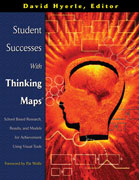



 dent Successes With Thinking Maps®
dent Successes With Thinking Maps®David Hyerle, editor with Sarah Curtis and Larry Alper co-editors
Chapter 12: Feeder Patterns and Feeding the Flame at Blalack Middle School
Edward V. Chevalleir, Ed.D.
“The maps have given my students a means of organization and a strategy to set-up and solve a multi-step problem, outline a project and much more.”
Teacher
“Can I use a thinking map to get started?”
Student
Thinking maps help students actively process information. The use of the maps creates immediate and specific questions. In a middle school classroom, the constant challenge is maximum engagement. Used in even their most limited form, thinking maps ensure eight “ready” questions—questions associated with each of the eight thinking skills. Thinking maps build a bridge from concrete knowledge to abstract concepts.
Thinking maps bridge the divide between concrete facts and abstract thinking as a developmental necessity for adolescents. Thinking maps give students a flexible structure for creating their own vision of knowledge as they create their own maps from blank paper. Because no map is ever complete, this flexibility ensures that students at all levels of growth can be consistently challenged in their thinking, building from concrete information to concept formation.
Thinking maps work as teaching, learning, and assessment tools. The flexible configurations of the maps allow all teachers to contribute to creating applications within and across content areas. Students can successfully use maps as independent learners and thinkers to organize their thoughts for note taking, on formative assessments, and on summative assessments. Many of my teachers regularly ask students to create one or several thinking maps to show what they know as they are developing ideas, structuring an essay, or responding to the typical questions that appear at the end of most chapters.
Read the complete chapter in the book Student Successes With Thinking Maps. Key sections from the chapter Feeder Patterns and Feeding the Flame at Blalack Middle School with excerpts above include:
- Lighting the Fire in a Middle School Setting
- Early Levels of Change and Concerns
- Communication for Differentiation
- Feeding the Fire: Confidence and Continued Success
Edward V. Chevallier, M.Ed. has enjoyed serving as a principal, teacher, and education consultant and Thinking Maps trainer. His work in public education began at the elementary school level as a teacher and principal. Since 1996, he has served as Principal at Blalack Middle School in Carrollton, Texas.
![]() Click here (pdf file) to download Research Highlights from
Click here (pdf file) to download Research Highlights from
Student Successes With Thinking Maps
For more on Student Successes With Thinking Maps go to the following links: